Alevemente is a term that has been gaining interest in recent years. It refers back to the subtle yet pervasive impact of positive elements in shaping individual behavior and societal traits. This article targets to discover the idea of alevemente, its origins, and its diverse implications in contemporary society. Through a detailed evaluation under 8 headings, we can delve into how alevemente operates and its capability effect on our lives.
The Origin of Alevemente
The time period alevemente is derived from the Latin words “aleve,” meaning mild or diffused, and “mente,” that means thoughts. It became first coined through sociologists inside the early twenty first century to explain the often ignored forces that affect human concept and conduct. These forces can be as diffused as cultural norms or as pervasive as technological improvements. The idea of alevemente emphasizes that now not all impacts are overt or aggressive; some paintings quietly within the history, shaping our perceptions and actions without our conscious recognition.
The Mechanisms of Alevemente
Understanding the mechanisms of alevemente requires a deep dive into psychology and sociology. It operates through a lot of channels, which includes media, education, and social interactions. For example, the way media portrays certain issues can subtly affect public opinion. Similarly, educational systems can embed particular values and perspectives in students, shaping their worldviews in the long run. Social interactions also play a important position; the evaluations and behaviors of peers and circle of relatives individuals can considerably effect an character’s beliefs and actions.
Alevemente in Media
The media is one of the maximum effective channels through which alevemente operates. Through selective reporting and framing of information, media shops can subtly affect public belief. For example, the manner a news story is presented—whether it emphasizes certain elements over others—can form how the target audience perceives the problem. Furthermore, amusement media, along with movies and tv indicates, can propagate positive stereotypes and norms, reinforcing unique behaviors and attitudes in society.
Alevemente in Education
Education systems are every other crucial street for alevemente. The curriculum, coaching methods, or even the hidden curriculum (the implicit instructions found out in faculty) can instill certain values and beliefs in college students. For example, history textbooks may present activities from a selected angle, shaping students’ know-how of their country wide identification and worldwide problems. Additionally, the emphasis on sure topics over others can influence career aspirations and societal roles.
Social Interactions and Alevemente
Social interactions are perhaps the maximum direct form of alevemente. From a young age, individuals are motivated by means of their own family, friends, and friends. These interactions can subtly form beliefs and behaviors via mechanisms along with social getting to know and conformity. For instance, youngsters often undertake the attitudes and behaviors of their dad and mom and peers, that may have an enduring impact on their destiny moves and choices. Moreover, the desire to in shape in and be usual can lead people to adopt the norms and values of their social organizations.
The Role of Technology in Alevemente
In the digital age, technology plays a substantial role in alevemente. The algorithms used by social media systems and serps can create echo chambers, wherein individuals are exposed mainly to statistics that aligns with their current ideals. This can toughen current biases and restrict exposure to numerous views. Additionally, focused advertising and customized content can subtly shape consumer behavior and possibilities, frequently with out the man or woman’s aware cognizance.
Alevemente in Consumer Behavior
Consumer conduct is another location wherein alevemente is in particular evident. Marketing and advertising and marketing strategies frequently rent diffused techniques to persuade shopping choices. For example, the use of sure shades, track, and imagery in advertisements can evoke specific emotions and associations, main purchasers to desire certain merchandise. Moreover, the strategic placement of products in stores and on-line structures can influence shopping for behavior via diffused cues and nudges.
The Ethical Implications of Alevemente
The idea of alevemente increases essential ethical questions. If people and societies are being subtly stimulated in methods they’re no longer fully privy to, what does this suggest for autonomy and unfastened will? There is a growing problem that alevemente may be used to control public opinion and behavior for profit or political benefit. This has caused calls for extra transparency and duty in media, schooling, and era. It also underscores the want for crucial questioning and media literacy abilties to assist people understand and resist diffused impacts.
Conclusion
Alevemente is a charming and complex phenomenon that highlights the diffused yet effective forces shaping our mind, behaviors, and societies. From media and training to social interactions and generation, alevemente operates through diverse channels, frequently with out our aware awareness. Understanding those mechanisms is crucial for fostering a extra knowledgeable and self sustaining society. As we navigate an increasingly complex world, recognizing and addressing the affect of alevemente can be critical for selling person autonomy and societal nicely-being.

5 Comments
Thanks for sharing. I read many of your blog posts, cool, your blog is very good.
Your blog entry has inspired me to make a move. I’m excited to try out your tips!
Thank you for your sharing. I am worried that I lack creative ideas. It is your article that makes me full of hope. Thank you. But, I have a question, can you help me?
I’m impressed by your natural ability to turn ordinary subjects into riveting content. Well done!
Fantastic post! Your writing is captivating and your ideas are very relevant. I learned a lot. Keep it up!